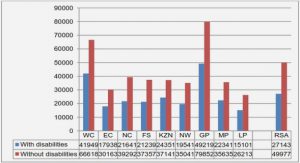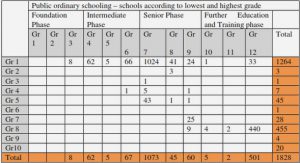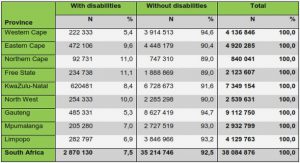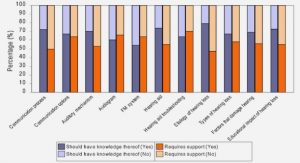Get Complete Project Material File(s) Now! »
Hypothesis on the model
The system is a circular Petri dish with a thin layer of distilled water. A laser source is placed under this sample and lights the bottom of the Petri dish. The laser beam is focused by a microscope objective. Water has a good absorption rate at the chosen wavelength (1480 nm). Different hypothesis on this system are proposed:
1. The laser light force is negligible compared to the thermal effect. The only body force is the Archimedes force.
2. The distilled water may be considered as a Newtonian fluid.
3. The geometry of the problem is cylindrical, so the problem is independent of θ coordinate.
4. Only the permanent regime is considered.
Comparison to experimental measurements of flows
To compare the simulation results with the experimentally measured flows, the speed of particles with image processing is measured. Hollow glass microspheres whose density is equivalent to water, and diameters between 8 and 12 μm are used. A standard CMOS camera (12 fps,) which gives a view from the bottom of the Petri dish, monitors the experiments. The displacement of the microscope objective changes the image focal plane as well as the laser focal plane. In this velocimetry experiment, 10 s data was taken for different depths of a given water layer thickness (same thickness during the recording while moving vertically the microscope objective). In consequence, the laser spot does not have the same position in the different experiments. The positions were measured manually on the recorded images. This first experimental protocol is not precise and does not allow the treatment of a huge number of data, however it was enough to evaluate the experimental velocity for the natural convection.
It is observed that toward the bottom of the petri dish the particles are directed toward the laser, and toward the free surface they moved away from the laser beam. At the bottom, many particles stick to the Petri dish surface. In Figure 2.8, the rectilinear trajectories and the axial symmetry of the flows are shown.
Figure 2.11 compares the experimental speed values with the simulations. A first observatio is that the speed is underestimated by the simulations. The reasons may be that the laser power is not well known after the objective, the simulations rely on hypothesis like the temperature independence of the physical parameters. Another reason may also be the influence of light forces, surface tension and surface deformation.
Thermocapillary convection
Before explaining the thermocapillary convection or convection flows due to variations in surface tension with respect to the temperature, a definition of surface tension is presented. The surface tensions play an important role in the equilibrium and flows of fluids.
Surface tension
Surface tension is the energy per unit surface that minimizes the surface interface between two fluids. For instance, a water drop takes a spherical shape to have a minimum surface interface in the air. This energy is due to the internal cohesion forces (van der Waals, hydrogens, ionic and metallic bonds) exerted between the fluid molecules. At the interface, these forces are unbalanced and the work per unit surface realized by the internal forces to keep the fluid in a steady state is the surface tension. It is expressed in N/m.
Surface tension varies with the presence of a surfactant or a temperature gradient. A surfactant, is a chemical substance composed of molecules having a hydrophilic head and a hydrophobic tail in presence of water. Thus, this substance lays at the interface between two fluids, where the hydrophilic head is in the water part and the hydrophobic tail is in the other medium. A surfactant decreases the surface tension between two fluids because of its affinity for both of them. Therefore, a surfactant concentration gradient induces a surface tension gradient. The surface tension variation also depends on the temperature. An increase of the temperature reduces the surface tension due to the reduction of the cohesion forces between the molecules of the fluid media. Therefore, a temperature gradient induces a surface tension gradient.
Marangoni effect
The Marangoni effect is the motion of a fluid due to a surface tension gradient (Maroto et al., 2007). As introduced above, this motion can be generated by a surfactant concentration gradient or a temperature gradient at the interface. The fluid motion due to a temperature gradient is also known as thermocapillary convection or B´enard-Marangoni convection.
The first person who observed this phenomenon was Henri B´enard. He investigated the behavior of a thin layer of whale oil by heating it from below with a heating plate. He observed a formation of hexagonal patterns at the free surface (B´enard, 1900). He determined that at the center of a hexagonal cell the flows go up, and at its borders the flows go down (see Figure 2.13). He also explained that in the warmer regions (border of the hexagon) the flows go up and in the colder regions (border of a hexagon) the flows go down (Figure 2.14.) However, he explained that this phenomenon is due to buoyant forces acting in the bulk of the fluid. In 1958, Pearson theoretically showed that B´enard observations were actually due to variations in surface tension caused by a temperature gradient (Pearson, 1958). This phenomenon is also known as Marangoni convection due to Marangoni’s work (Marangoni, 1871).
As this phenomenon is established by surface forces, it is more suitable to work at small scales. For instance, taking L as a characteristic length, surface tension is proportional to L, pressure forces are proportional to L2 and volumetric forces are proportional to L3; therefore at small scales the Marangoni effect becomes more significant.
Microheat source: Infrared laser = 1480 nm
The actuation principle is based on thermal phenomena. A local heat source is hence needed to produce thermal energy in the liquid medium.
There are different ways to generate heat in microfluidic systems for thermal-based micromanipulation, such as microheaters (Darhuber et al., 2003), microresistors (Basu & Gianchandani, 2009) and photothermal effect (Ohta et al., 2007). In the case of microheaters, they have to be patterned onto a substrate surface in defined paths by microfabrication processes. This approach is limited to manipulate microparts of predefined size. The displacement precision can not be varied which make this process not flexible. Moreover, it is challenging to connect independently the microheaters. Microresistors have the same drawbacks mentioned above. On the other hand, Ohta et al., 2007 uses localized non-coherent light absorption onto a photopolymeric substrate. The heat produced by absorption in the substrate is transferred to the liquid medium engendering thermocapillary forces that move air bubbles.
We propose an addressable laser beam as the heat source. As laser absorption depends on the liquid media, an infra red diode laser with 1480 nm in wavelength and 120 mW in power is used. At this wavelength the absorption coefficient of water is 23.45/cm as shown in the absorption spectrum in Figure 3.2. This kind of diode laser source is generally used in biomedical application such as in vitro fertilization (Hollis et al., 1996).
2-DOF mirror scanner
In order to be able to address any position on the sample, the laser beam has to be moved and controlled. Several techniques are mentioned in the literature, such as holograms using a spatial light modulator (Cordero et al., 2008), acousto-optic deflectors (Ferrari et al., 2005; Reddy & Saggau, 2005), microlens array (Merenda et al., 2007), or laser scanning with galvanometric mirrors (Arai et al., 2004).
In this work, an 2-DOF TIP/TILT laser scanner (cf. Figure 3.3) is used to address the laser and to perform different scanning patterns. This device, developed by (Roselier & Hafez, 2006), is a compact mechatronic system actuated by four electromagnets in a push-pull antagonistic configuration. The forces exerted by the actuators are illustrated in Figure 3.3b. The magnitudes of these forces are identical for each magnet. They are placed on four cardinal positions around the pivot of the mirror holder. Hence, a couple of magnets induces 1 degree of freedom in rotation. Due to its dimensions (50×50×15 mm3) the scanner is easy to mount on the inverted microscope, under the nosepiece as shown in Figure 3.4.
As seen in Figure 3.3c, a dichroic mirror is mounted on the scanner’s flat plate in order to reflect the laser beam. The scanner is mounted onto the microscope in such a way that its flat plate would be in vertical position under the microscope objective. Then the dichroic mirror is placed onto the flat plate with a 45◦ angle. In this configuration, the dichroic mirror makes a 45◦ angle with the incident laser beam and the microscope optical axis. As shown in Fig. 3.5, this configuration allows to address the laser on the sample without interfering with the imaging light toward the high-speed camera, thus reducing considerably the laser beam optical path. Also, the compactness of the configuration ensures that the micromanipulation system would fit within the inverted microscope.
The disturbed fluidic zone
When heating a thin water layer from below using an IR laser, toroidal-shaped subsurface flows are generated around the focal point. Localized high-speed flows can then be shaped within an extent water layer. Micro-objects remaining within this region are dragged toward the focal point by the subsurface flows, and dragged away by the surface flows.
The IR laser is shot at the middle of a petri dish containing distilled water and hollow glass beads ranging from 8 up to 12 μm used as tracers. Their densities are close to water density.
Figure 3.7 shows a region of convection flows (lighter gray zone) while focusing at the petri dish’s surface. This region appears when the laser is shot. Beads within this part are radially dragged by the flow toward the center, where the laser is focused. At this point beads are directed toward the water surface and they start going out of focus. Therefore a darker zone is built up. This picture was taken when the convection region reaches its maximum diameter. The water depth is 450 μm and the measured radius is about 2.15 mm.
In Figure 3.8 the variation of the fluidic radius with respect to the water depth is shown. Three different water depths, 150, 300 and 450 μm are compared. The fluidic flow radius increases with the water depth. For a depth of 150 μm a radius of about 1.2 mm is obtained; and respectively a radius of 2.15 mm for 450 μm in water depth. Each measurement is repeated five times.
In Figure 3.9 an image sequence of a convection cell build-up is depicted. Ten images are shown at 110 ms intervals. Images capture rate is 100 Hz. It was observed that at 20 ms particles laying at the bottom surface starts moving. The time for the convection cell to reach its maximum diameter is about 1 s. At 220 ms, the diameter is already about 70% of its maximum value.
Table of contents :
List of Figures
List of Tables
Notations
Introduction
1 Non-contact micromanipulation
1.1 Electric field driven effects
1.2 Dielectrophoresis
1.3 Optical tweezers
1.4 Electrowetting
1.5 Magnetic manipulation
1.6 Acoustic waves
1.7 Manipulation via actuated flows
1.8 Summary
1.9 Conclusions
2 Opto-fluidic actuation for non-contact micromanipulation
2.1 Theoretical background
2.1.1 The fluid mechanics laws
2.1.2 Hypothesis on the model
2.1.3 Dimensionless numbers
2.2 Natural convection
2.2.1 The microfluidic system
2.2.2 Simulations
2.2.3 Comparison to experimental measurements of flows
2.3 Thermocapillary convection
2.3.1 Surface tension
2.3.2 Marangoni effect
2.3.3 Working principle
2.3.4 Formulation
2.4 Conclusions
3 Experimental analysis of thermal-induced convection flows
3.1 Introduction
3.2 Experimental set-up
3.2.1 Microheat source: Infrared laser λ = 1480 nm
3.2.2 2-DOF mirror scanner
3.2.3 Sample preparation
3.3 Experimental analysis of convection flows
3.3.1 The disturbed fluidic zone
3.3.2 Velocity measurements
3.3.3 Influence of larger beads
3.3.4 Micro-objects floating on the water-air interface
3.3.5 Estimation of the manipulation force
3.4 Conclusions
4 Toward a fully automated vision-based opto-fluidic system for non-contact micromanipulation
4.1 Vision feedback for micromanipulation
4.1.1 Optical flow
4.1.2 Image segmentation
4.1.3 Hough transform
4.1.4 Image correlation
4.2 System calibration
4.3 Micromanipulation: Operation modes
4.3.1 Manual operation mode
4.3.2 Automatic operation mode
4.4 Conclusions
Conclusions and Perspectives
Bibliography




